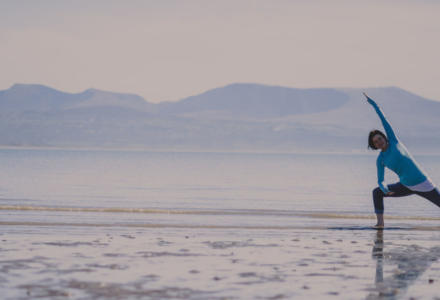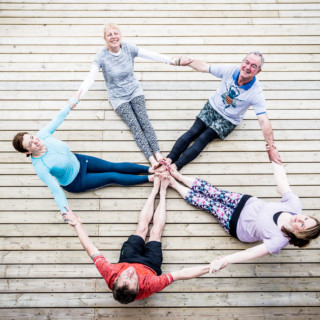
Found your teacher? Next steps ...
First steps into yoga. It’s hard to know where to start with anything new. That’s OK. That’s why you’re here on this page…. Here are 10 things to consider about what essentials you’ll need to get started and how to top up your yoga buzz when you get home.

Kate and students having a play with Partner Yoga
- Don’t go out and buy lots of yoga gear before you have tried a few classes and found a teacher that makes you feel all warm and fuzzy inside. Most teachers will have a spare mat and kit, especially if you have spoken to them prior to your first class and they know you are a beginner. First class? Wear comfortable clothes, take a blanket as this can be used to cushion delicate knees, sit on folded for meditation and to get cosy for relaxation at the end of class. Don’t forget your re-fillable water bottle.
- Once you’re happy that Yoga is for you... (Yippeeee, welcome to The Best Club Ever) next on your to-do-list is buying some yoga kit. Your teacher may provide some kit for classes, ask them what you need to bring every week to class.
- For practise at home, you will need a good quality yoga mat. The cheap ones have nasty plastic chemicals in, so expect to pay £20-25 for a decent mat and check out the Eco credentials first. Look for Toxin-free Yoga mats, free from phthalates especially. You want a sticky mat so that you don’t slip and about 4mm thick, good for knee comfort, but not too thick for balances. (Pilates mats tend to be too thick for yoga, very wobbly in Tree Pose, too stretchy for Warrior Pose!)
- Wear stretchy yoga pants / leggings without thick seams or pockets/zips that will dig in when you lie down, a close fitting T-shirt is a good idea, so that it doesn’t ride up when you’re upside down and if you have long hair, bun it up somehow so you can actually see your yoga teacher! I recommend Bamboo Yoga clothes, as Bamboo is the most world's most sustainable crop and it is SO soft and comfortable.
- A blanket helps to keep your body temperature regular as you cool down for relaxation, no need to buy a special one for yoga if you have some at home already. Also useful to pad delicate knees in Cat Pose if needs be.
- You may want to buy a yoga block or two. I mostly use the two-inch rectangular blocks for sitting on; they can also support you in Child’s Pose, Hero pose and help you out in a forward bend to touch the floor (it is a surprisingly long way down). The yoga bricks are useful to support you in more complex postures - get them later!
- A yoga strap (or dressing gown belt) strap is useful to get the most out of specific stretches – hamstrings, chest stretches for example.
- A cushion or two from your sofa for extra padding under delicate knees or under your head and legs for relaxation.
- After a few weeks of classes, you will have all your kit sorted and probably a nice yoga bag too to carry it all in and store it together at home so you don’t forget anything next time you head out the door for your class or roll out you mat in the lounge.
- Try to practise a little bit of what you have learnt at home in-between classes. Online Yoga Studios are great for this, but choose one that dovetails into your Yoga teacher’s style. Ask them for one they would recommend. Find a time of the day that suits you. For example, after a shower in the morning or after the school run or work. Before bed is a nice time to do a few stretches or a spot of meditation.
Yoga is immediately rewarding, whatever your level, because it's not about being able to attain the perfect lotus position. Each day, there is an improvement on the day before. It's not competitive; it's not a race. With yoga, the journey is the destination
Trudie Styler